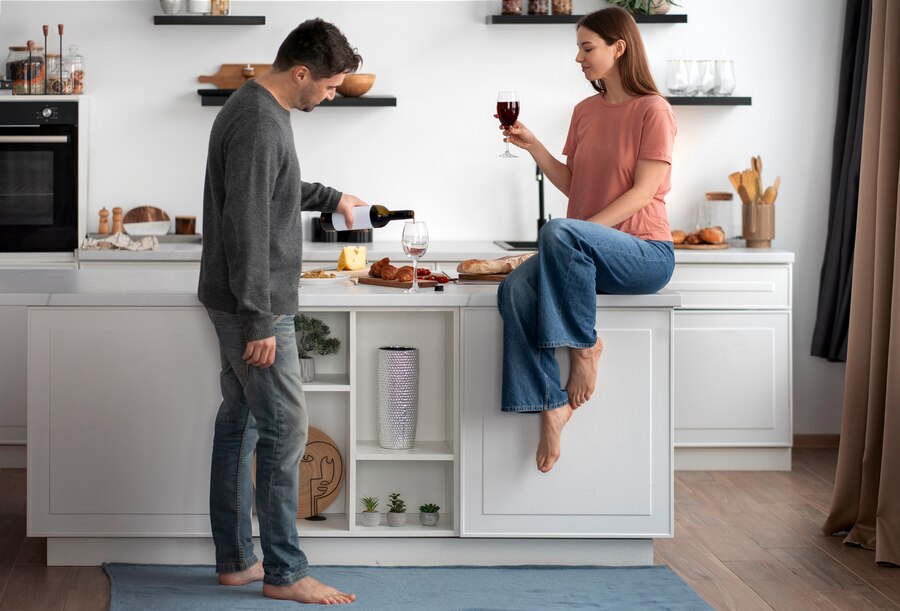When designing or renovating a kitchen, choosing the right cabinetry style is one of the most important decisions you’ll make. Cabinets are not just functional storage spaces; they significantly influence the overall aesthetic and ambiance of your kitchen. Among the various types of cabinets available, two popular styles often come into focus—inset cabinets and overlay cabinets. Both offer unique benefits and can transform the look of your kitchen in different ways.
In this article, we will compare inset and overlay cabinets, explore their design advantages, and provide insights to help you determine which option best fits your style, needs, and kitchen layout.
What Are Inset Cabinets?
Inset cabinets are a classic style that dates back to the early 20th century. As the name suggests, the cabinet doors and drawers are set inside the cabinet frame, creating a flush, streamlined appearance. This construction technique requires precision craftsmanship to ensure that the doors fit perfectly within the frame, allowing for smooth opening and closing.
1. Design Aesthetics
The hallmark of inset cabinets is their clean, minimalist look. Because the doors are recessed into the frame, they create a seamless and sophisticated appearance that appeals to homeowners who appreciate timeless, traditional designs. Inset cabinets often feature exposed hinges, adding a touch of elegance and a sense of craftsmanship.
Inset cabinetry pairs well with a variety of kitchen styles, particularly those leaning toward classic, farmhouse, or Shaker designs. However, they can also work in transitional kitchens that blend traditional and modern elements.
2. Durability and Longevity
Inset cabinets are known for their durability due to their precise construction. Because they are custom-built to fit flush within the frame, they can stand up to years of use without warping or sagging. However, it’s important to note that this style requires careful installation to avoid misalignment that could affect the door’s operation.
With proper care and maintenance, high-quality inset cabinets, like those from The Cabinet Shop, can offer long-term functionality and continue to look great in your kitchen for decades.
3. Storage Considerations
One downside of inset cabinets is the slight reduction in storage space compared to overlay styles. Since the doors sit inside the frame, they take up a bit of the internal cabinet space. While this difference may seem small, it’s something to consider if you’re working with a compact kitchen and need to maximize every inch of storage.
What Are Overlay Cabinets?
Overlay cabinets, in contrast to inset cabinets, have doors and drawer fronts that sit on top of the cabinet frame. There are two types of overlay cabinets: full overlay and partial overlay.
- Full Overlay: In this style, the doors and drawers cover the entire face frame, leaving very little gap between each door and drawer. This creates a sleek, modern appearance.
- Partial Overlay: In partial overlay cabinets, a portion of the frame remains visible, giving the cabinets a more traditional or transitional look.
1. Modern Appeal
Full overlay cabinets are a favorite in contemporary and modern kitchens due to their smooth, uninterrupted appearance. With the doors covering the frame entirely, they offer a uniform, streamlined look that many homeowners find appealing. This style works well with flat-panel doors and is often chosen for minimalist or industrial kitchen designs.
Partial overlay cabinets, on the other hand, allow for a bit more design flexibility. They retain some of the frame’s visibility, making them suitable for both modern and more traditional kitchen styles.
2. Easier Installation and Affordability
One advantage of overlay cabinets is that they are easier to install than inset cabinets. Since the doors rest on top of the frame, they don’t require the precise measurements and alignment that inset cabinets do. This also makes overlay cabinets more budget-friendly, as the installation process is simpler and less labor-intensive.
If you’re working with a tight budget, overlay cabinets may be a more accessible option without sacrificing style or functionality.
3. Maximized Storage Space
Another significant advantage of overlay cabinets is that they maximize storage space. Since the doors are placed over the frame rather than inside it, you can use the full interior space of each cabinet. This makes overlay cabinets an excellent choice for smaller kitchens where every inch of storage counts.
Key Differences Between Inset and Overlay Cabinets
Now that we’ve covered the basics of both styles, let’s look at the key differences that will help you decide which option is right for your kitchen.
1. Aesthetic Style
- Inset Cabinets: Offer a flush, clean look with visible hinges that can add a classic or vintage charm. They are ideal for traditional or transitional kitchens.
- Overlay Cabinets: Create a modern, sleek appearance, particularly in full overlay styles. They are versatile enough to fit into both contemporary and transitional designs.
2. Construction and Installation
- Inset Cabinets: Require precise craftsmanship and more detailed installation, which can increase costs. The flush doors demand careful alignment to ensure smooth operation.
- Overlay Cabinets: Easier to install, with doors that simply sit on the frame. This makes them a more budget-friendly option for homeowners who want to achieve a stylish kitchen without a complex installation process.
3. Storage and Functionality
- Inset Cabinets: Lose a small amount of storage space due to the recessed door design. However, they offer a more custom-built, high-end feel.
- Overlay Cabinets: Provide maximum storage capacity, making them ideal for smaller kitchens or those who need more room for cookware, appliances, or pantry items.
Choosing the Best Option for Your Kitchen
When deciding between inset and overlay cabinets, consider both your design preferences and your practical needs.
- If you love a timeless, traditional look and are willing to invest in precision craftsmanship, inset cabinets may be the best choice for you. They bring an air of elegance and refinement, making them perfect for those who want a high-end kitchen design.
- On the other hand, if you prioritize maximizing storage space and are working within a budget, overlay cabinets offer more flexibility in terms of cost and function. Full overlay cabinets are ideal for those aiming for a modern, seamless kitchen, while partial overlay provides a more balanced, transitional style.
Additionally, the kitchen’s size and layout should play a role in your decision. For smaller kitchens where every inch of storage matters, overlay cabinets may offer better practicality. For larger kitchens with more design freedom, inset cabinets can enhance the overall aesthetic with their clean lines and polished look.
Integrating Custom Cabinetry into Your Design
No matter which style you choose, custom cabinetry allows you to tailor your kitchen to your exact needs. For homeowners who want to blend aesthetics and practicality, working with professionals like The Cabinet Shop can help bring your vision to life. From selecting the right materials to designing custom storage solutions, custom cabinets offer endless possibilities for personalizing your kitchen.
By choosing custom cabinets, whether inset or overlay, you’ll have the freedom to optimize your kitchen’s functionality and style, ensuring that your space is both beautiful and practical for years to come.
Conclusion
Both inset and overlay cabinets offer distinct benefits, from aesthetic appeal to practical functionality. Your choice will ultimately depend on your personal style preferences, the layout of your kitchen, and your storage needs. While inset cabinets bring a timeless, crafted look, overlay cabinets offer modern appeal and increased storage capacity.
Whichever option you choose, investing in quality cabinetry can transform your kitchen into a space that is not only functional but also reflects your unique taste. Consider consulting experts like The Cabinet Shop for tailored cabinetry solutions that meet your design goals and enhance your home’s value.
This article follows a new structure and places the brand mention in a different location. Let me know if you need any adjustments before moving on to the next one!










